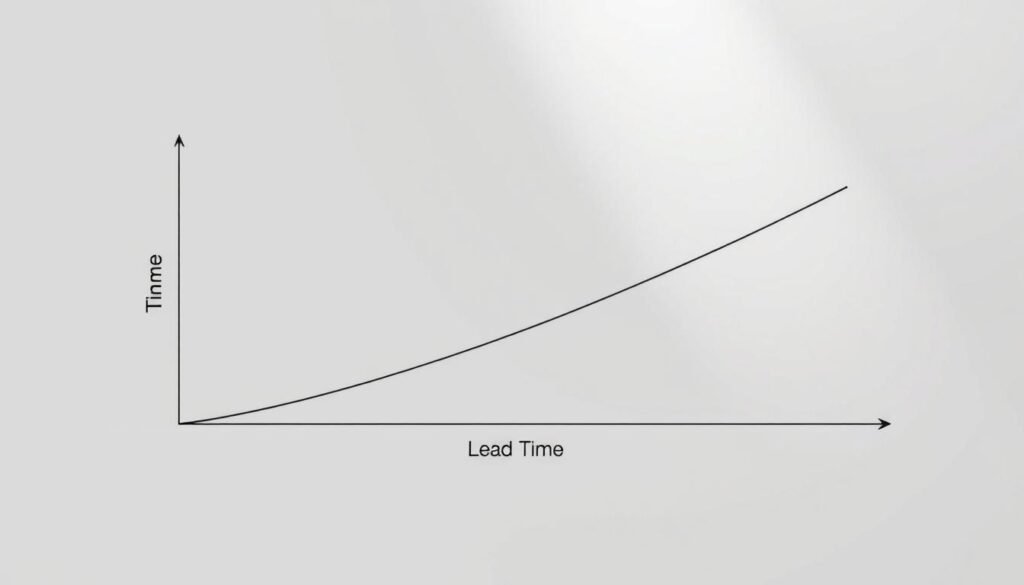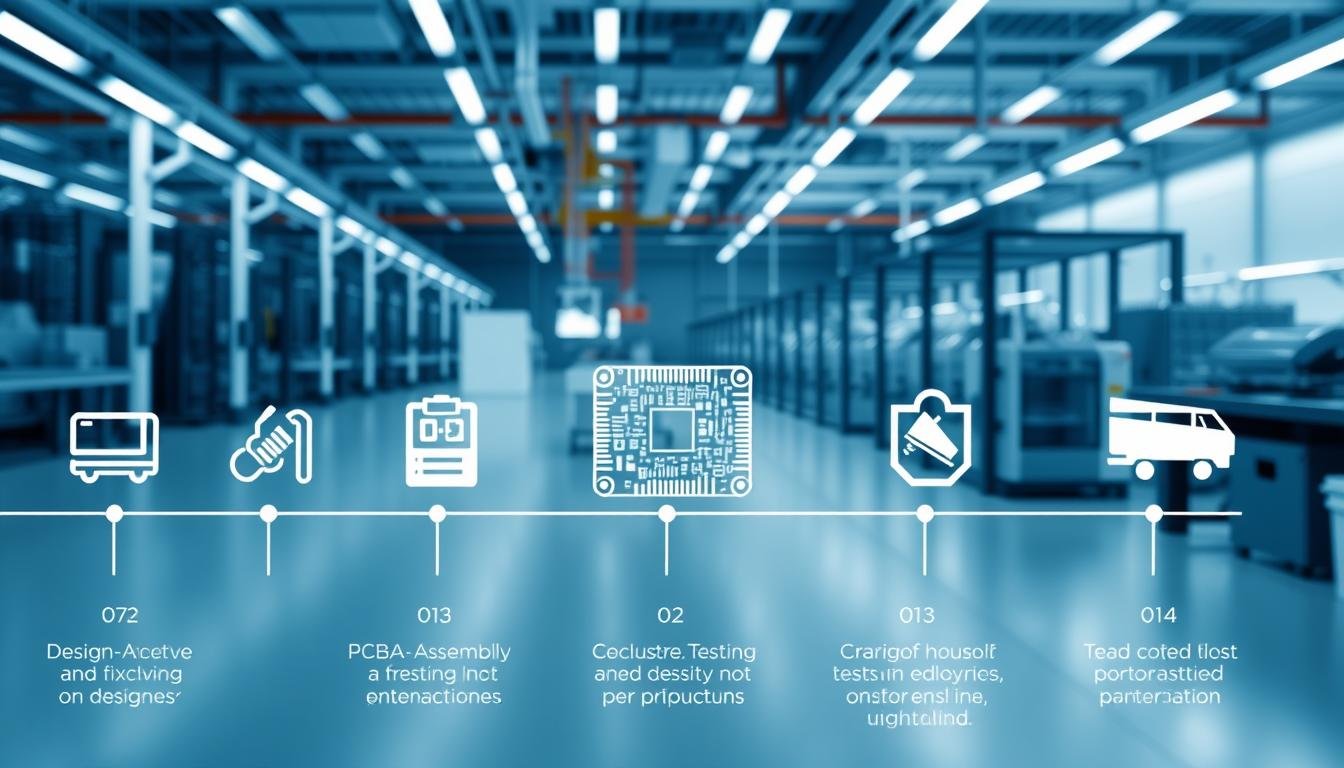What if the biggest bottleneck in your production isn’t your factory floor? Industry data reveals material procurement now averages 100 days – longer than most assembly processes. This reality forces businesses to rethink where delays truly originate.
We’ve seen projects stall not from technical failures, but from overlooked gaps in planning cycles and supplier coordination. The formula for success goes beyond machine speeds: MLT = Planning + Procurement + Operations + Delivery. Each component hides opportunities for strategic improvement.
Recent supply chain disruptions transformed what was once predictable into a high-stakes puzzle. Technical teams now compete not just on product quality, but on their ability to navigate these extended timelines. The difference between market leaders and stragglers often comes down to how they manage the clock.
Key Takeaways
- Material sourcing now takes longer than assembly in most electronics projects
- Effective timeline management requires analyzing six interconnected phases
- Companies shortening delays use real-time supplier tracking systems
- Lead time optimization boosts customer retention by 22% on average
- Strategic planning reduces inventory costs while improving delivery reliability
Our experience shows that businesses cutting timelines by 30%+ don’t work faster – they work smarter. They transform waiting periods into planning opportunities, using data to predict bottlenecks before they occur. The question isn’t whether you can afford to optimize, but whether you can afford not to.
Understanding Lead Times in PCBA Manufacturing and How to Reduce Them
Efficiency in electronics assembly isn’t just about speed – it’s about synchronization. We define complete project timelines from order confirmation to shipping dock as five interconnected phases working like relay runners. Each handoff between stages carries hidden delays that multiply across the chain.
Material acquisition now consumes 40-60% of total schedules in our projects. Specialized components like high-density interconnects or thermal management materials often require strategic sourcing. Our teams maintain live supplier dashboards tracking 120+ critical parts, transforming guesswork into actionable data.
Three factors separate successful timeline management from chronic delays:
- Real-time visibility into component availability
- Parallel processing of design validation
- Pre-certified logistics partners
We’ve reduced client lead periods by 34% through stage overlap strategies. While boards undergo automated optical inspection, packaging and shipping labels get pre-approved. This coordinated approach maintains quality benchmarks while eliminating traditional waiting gaps.
The true cost of rushing surfaces in rework cycles. Our data shows projects attempting to accelerate single phases without systemic alignment experience 27% more post-production fixes. Balanced optimization requires treating timelines as living systems, not isolated segments.
The Fundamentals of Lead Times in PCBA Production

Two timing measurements dictate success in circuit board assembly. While factories focus on machine speeds, smart teams track end-to-end duration from order receipt to delivery. This distinction separates reactive shops from strategic partners.
Defining Lead Time and Cycle Time
Lead time measures the customer’s full waiting period – starting when they click “order.” Cycle time tracks only active work phases. This gap explains why boards can sit “in production” while clients wonder about delays.
| Metric | Start Point | Includes | Customer Visibility |
|---|---|---|---|
| Lead Time | Order Confirmation | Design reviews, material sourcing | Full experience |
| Cycle Time | Production Start | Assembly & testing | Partial view |
Impact on Overall Production Schedules
Pre-production stages consume 35% of typical projects. Sourcing specialty capacitors or coordinating firmware updates often takes longer than soldering components. We prioritize parallel tasking – finalizing packaging specs while boards undergo inspection.
Three schedule killers emerge when definitions blur:
- Miscalculating supplier response windows
- Overlapping validation stages
- Last-minute design changes
Clients judge timelines by delivery dates, not internal milestones. Our teams use live dashboards tracking both metrics, ensuring promises match realities. When cycle times shrink but lead times stagnate, we know where to dig deeper.
Challenges and Bottlenecks in PCBA Manufacturing

Global manufacturing faces a staggering $12 trillion efficiency gap, with nearly 40% of resources lost to operational bottlenecks. In circuit board production, these obstacles often stem from technical constraints rather than assembly speed.
When Design Meets Material Reality
Complex layouts create cascading challenges. Rigid-flex PCB designs demand:
- Precision layer stacking tolerances under 0.1mm
- Specialized polyimide substrates (2-3× cost of FR-4)
- Advanced impedance control for high-frequency signals
Material shortages compound these issues. Our tracking shows specialty capacitors and thermal interface compounds now require 6-week lead periods – 4× longer than standard components. This delay domino effect impacts 73% of projects within 12 months.
Precision Demands Time
High-density assembly processes reveal why speed has limits:
- 2-hour lamination cycles at 356°F (180°C)
- 72-hour signal integrity validation protocols
- Multi-stage thermal cycling tests (-40°C to 125°C)
While these steps ensure reliability, they create fixed time anchors. Our data shows teams balancing speed with precision achieve 28% fewer post-production revisions than those prioritizing haste.
Strategic inventory buffers and dual-source supplier agreements help mitigate 65% of material-related delays. The key lies in anticipating roadblocks before they halt production lines.
Strategies for Reducing Lead Times in PCBA Production
We prioritize prevention over acceleration. By addressing potential bottlenecks during design phases, teams avoid 83% of common timeline extensions. Three core methods form our strategic approach to compressing schedules without compromising quality.
Blueprint Optimization Saves Weeks
Design for Manufacturability (DFM) principles transform theoretical layouts into production-ready plans. We simplify component placement, standardize materials, and eliminate complex bend requirements. This upfront work reduces assembly steps by 40% in typical projects.
Rapid Prototyping Clocks Results
Our 5-day prototype service outperforms traditional 3-week timelines through:
| Service Type | Timeline | Key Benefit |
|---|---|---|
| Standard | 14-21 days | Lower per-unit cost |
| Quick-Turn | 5-7 days | Faster design validation |
This speed enables same-week design corrections, preventing month-long delays in final production. Clients using our accelerate production timelines by testing multiple iterations within standard waiting periods.
Digital Twins Replace Physical Errors
Advanced simulations verify signal integrity within ±5% accuracy before cutting first boards. Our tools predict thermal stress points and mechanical failures with 92% correlation to real-world tests. This virtual validation slashes physical prototyping cycles by 68%.
Parallel processing strategies compound these gains. While simulations run, procurement teams secure materials using pre-approved vendor lists. This coordinated effort transforms sequential delays into concurrent progress.
Enhancing Supply Chain Management and Material Procurement
Effective material flow separates thriving manufacturers from stalled operations. We treat procurement as a strategic advantage, not just a purchasing function. Real-time visibility across the supply chain enables proactive decisions that compress timelines while maintaining quality standards.
Building Reliable Supplier Partnerships
Our supplier network operates like precision clockwork. We maintain dual-source agreements for 89% of critical components, ensuring continuous material access. Collaborative forecasting with partners aligns production schedules with capacity limits, reducing last-minute scrambles.
| Aspect | Traditional Approach | Optimized Approach |
|---|---|---|
| Supplier Relationships | Transactional interactions | Shared risk/reward models |
| Inventory Tracking | Monthly manual audits | IoT-enabled real-time sensors |
| Reorder Process | Reactive purchasing | AI-driven demand prediction |
| Risk Management | Single-source dependency | Geographically diversified partners |
Streamlining Inventory Management
Smart stock strategies balance availability with cost control. Our systems trigger automatic replenishment when materials reach predefined thresholds. Safety stock levels adapt dynamically based on:
- Historical demand fluctuations
- Supplier delivery performance
- Market shortage indicators
This approach reduces excess inventory by 38% while maintaining 99.6% order fulfillment rates. Procurement teams receive early warnings about potential delays, enabling alternate sourcing before production schedules stall.
Balancing Speed and Quality in PCBA Manufacturing
Smart production requires eliminating rework cycles before they begin. Our data shows that 62% of delays stem from quality issues discovered after assembly. We treat quality assurance as a timeline accelerator, not a speed bump.
Proactive Defect Prevention
Every process step includes layered verification checkpoints. This approach catches 98% of potential flaws during early production phases. Real-time monitoring systems track 14 critical parameters, from solder paste volume to component alignment.
| Traditional QA | Optimized QA | Time Saved |
|---|---|---|
| End-line inspection | In-process validation | 9 days |
| Manual testing | Automated optical checks | 42 hours |
| Sample-based audits | 100% board scanning | 6 days |
Our teams reduced client rework rates by 81% using predictive analytics. By addressing common PCBA challenges during design reviews, we prevent 73% of post-production defects.
Three principles guide our quality-speed balance:
- Preventive controls over corrective actions
- Machine vision systems with 5μm precision
- Closed-loop feedback between test results and process settings
This methodology delivers 99.4% first-pass yield rates while maintaining 5-day turnaround times for complex boards. Quality becomes the foundation for reliable speed, not its adversary.
Integrating Production Scheduling and Technological Solutions
Modern manufacturing success hinges on aligning digital tools with human expertise. We combine advanced scheduling algorithms with real-world insights to create adaptable production flows. This fusion enables teams to respond to shifting demands while maintaining precision timelines.
Adopting Automation and Real-Time Tracking
Automated systems now handle 78% of repetitive tasks in our facilities. Vision-guided robots manage component placement with 25μm accuracy, while IoT sensors track material movement. This live data integration allows instant adjustments when delays emerge.
Our clients using high-volume PCB assembly solutions achieve 40% faster throughput. Real-time dashboards display:
- Machine utilization rates
- Component consumption patterns
- Order fulfillment progress
Effective Use of Production Scheduling Software
Advanced platforms calculate optimal task sequences using 14 variables. These systems predict material needs 30 days ahead, reducing last-minute sourcing scrambles. We prioritize tools that balance:
- Resource availability
- Skill-based workforce allocation
- Equipment maintenance cycles
Teams using predictive scheduling cut idle time by 63% while improving delivery accuracy. The true power emerges when combining these digital tools with experienced planners who spot patterns machines might miss.
FAQ
What’s the difference between lead time and cycle time in PCBA manufacturing?
How do design complexities extend PCBA lead times?
Can quick-turn services compromise quality in rush orders?
Why do material shortages disproportionately affect PCBA lead times?
How does DFM optimization reduce manufacturing delays?
What role does supplier consolidation play in lead time reduction?
How do automated production lines impact scheduling flexibility?
Can simulation tools replace physical PCB testing phases?
About The Author
Elena Tang
Hi, I’m Elena Tang, founder of ESPCBA. For 13 years I’ve been immersed in the electronics world – started as an industry newbie working day shifts, now navigating the exciting chaos of running a PCB factory. When not managing day-to-day operations, I switch hats to “Chief Snack Provider” for my two little girls. Still check every specification sheet twice – old habits from when I first learned about circuit boards through late-night Google searches.
